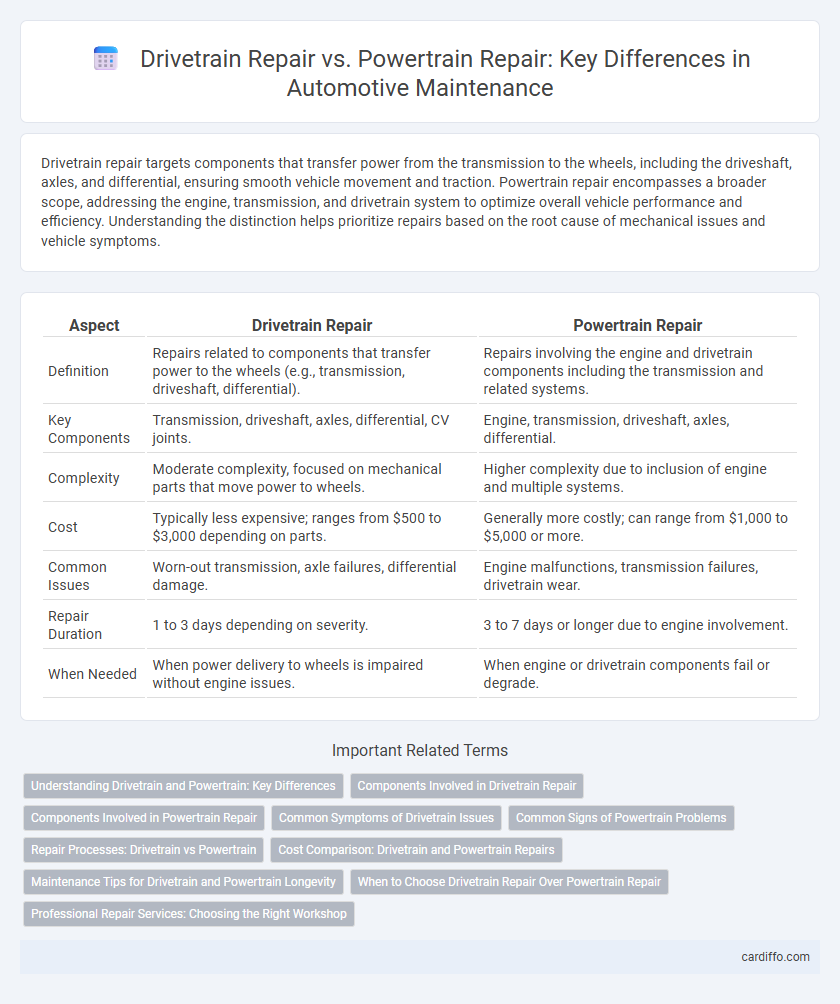Drivetrain repair targets components that transfer power from the transmission to the wheels, including the driveshaft, axles, and differential, ensuring smooth vehicle movement and traction. Powertrain repair encompasses a broader scope, addressing the engine, transmission, and drivetrain system to optimize overall vehicle performance and efficiency. Understanding the distinction helps prioritize repairs based on the root cause of mechanical issues and vehicle symptoms.
Table of Comparison
| Aspect | Drivetrain Repair | Powertrain Repair |
|---|---|---|
| Definition | Repairs related to components that transfer power to the wheels (e.g., transmission, driveshaft, differential). | Repairs involving the engine and drivetrain components including the transmission and related systems. |
| Key Components | Transmission, driveshaft, axles, differential, CV joints. | Engine, transmission, driveshaft, axles, differential. |
| Complexity | Moderate complexity, focused on mechanical parts that move power to wheels. | Higher complexity due to inclusion of engine and multiple systems. |
| Cost | Typically less expensive; ranges from $500 to $3,000 depending on parts. | Generally more costly; can range from $1,000 to $5,000 or more. |
| Common Issues | Worn-out transmission, axle failures, differential damage. | Engine malfunctions, transmission failures, drivetrain wear. |
| Repair Duration | 1 to 3 days depending on severity. | 3 to 7 days or longer due to engine involvement. |
| When Needed | When power delivery to wheels is impaired without engine issues. | When engine or drivetrain components fail or degrade. |
Understanding Drivetrain and Powertrain: Key Differences
Drivetrain repair focuses on maintaining and fixing components that transfer power from the transmission to the wheels, including axles, driveshaft, and differential. Powertrain repair encompasses a broader scope, covering the engine, transmission, and drivetrain components essential for vehicle movement and performance. Understanding these distinctions helps pinpoint whether repairs should target power delivery systems or the engine itself, optimizing diagnostic accuracy and repair efficiency.
Components Involved in Drivetrain Repair
Drivetrain repair primarily involves components such as the transmission, driveshaft, axles, and differentials, which work together to transfer power from the engine to the wheels. These parts ensure efficient torque delivery and vehicle movement, requiring precise diagnostics and specialized repair techniques. Unlike powertrain repair, which also includes engine maintenance, drivetrain repair focuses on maintaining the integrity of the mechanical linkages that propel the vehicle.
Components Involved in Powertrain Repair
Powertrain repair encompasses a broader range of components including the engine, transmission, and drivetrain systems such as the driveshaft and differential. This repair targets any part responsible for generating and delivering power to the wheels, ensuring optimal vehicle performance. Addressing issues in the powertrain typically involves specialized diagnostics and component replacements or refurbishments for comprehensive functionality restoration.
Common Symptoms of Drivetrain Issues
Common symptoms of drivetrain issues include grinding or clunking noises during acceleration, difficulty in shifting gears, and vibrations felt through the steering wheel or vehicle body. Drivetrain problems often manifest as leaks from differential or transmission seals, uneven tire wear, and reduced vehicle power or responsiveness. Early diagnosis of these symptoms can prevent more extensive damage to components like axles, driveshafts, and CV joints.
Common Signs of Powertrain Problems
Common signs of powertrain problems include unusual vibrations, loss of power during acceleration, and strange noises such as grinding or clunking coming from the engine or transmission. Difficulty shifting gears, warning lights like the check engine light, and fluid leaks around the transmission area often indicate underlying issues. Diagnosing these symptoms early is crucial for preventing extensive damage and costly repairs in both powertrain and drivetrain components.
Repair Processes: Drivetrain vs Powertrain
Drivetrain repair primarily involves the maintenance and replacement of components such as the transmission, driveshaft, and differential, focusing on transferring power from the engine to the wheels. Powertrain repair encompasses a broader scope including the engine, transmission, and related systems critical for vehicle propulsion. The repair process for drivetrain issues often requires disassembly of drive components, while powertrain repair demands advanced diagnostics and precise engine tuning to restore optimal performance.
Cost Comparison: Drivetrain and Powertrain Repairs
Drivetrain repair typically costs less than powertrain repair due to the drivetrain's focus on components like the transmission, driveshaft, and differential, whereas powertrain repair encompasses the engine and transmission, leading to higher expenses. On average, drivetrain repairs range from $500 to $1,500, while powertrain repairs can exceed $3,000 depending on the severity of engine or transmission damage. Understanding these cost differences helps vehicle owners budget effectively for maintenance and avoid unexpected high repair bills.
Maintenance Tips for Drivetrain and Powertrain Longevity
Regularly inspecting and lubricating drivetrain components such as the driveshaft, differential, and CV joints helps prevent premature wear and ensures smooth power delivery. Maintaining optimal fluid levels and changing transmission and engine oils according to manufacturer guidelines supports powertrain health by reducing friction and dissipating heat. Monitoring for unusual noises, vibrations, and leaks allows early detection of issues, extending the lifespan of both drivetrain and powertrain systems.
When to Choose Drivetrain Repair Over Powertrain Repair
Choose drivetrain repair over powertrain repair when issues are isolated to components like the transmission, driveshaft, or axles, affecting power delivery rather than the engine itself. Drivetrain repairs address problems such as clutch failure, differential damage, or CV joint wear without involving the engine or fuel system. Prioritizing drivetrain repair reduces costs and downtime when the engine and other powertrain elements remain fully functional.
Professional Repair Services: Choosing the Right Workshop
Professional repair services specializing in drivetrain repair focus on components such as the transmission, driveshaft, and differential, ensuring precise diagnosis and targeted fixes for optimal vehicle performance. Powertrain repair services encompass a broader scope, including the engine, transmission, and drivetrain, requiring workshops with certified technicians and advanced diagnostic tools for comprehensive maintenance. Choosing the right workshop involves assessing technical expertise, service certifications, and customer reviews to guarantee efficient, reliable repairs tailored to the specific system needs of your vehicle.
Drivetrain repair vs powertrain repair Infographic

 cardiffo.com
cardiffo.com